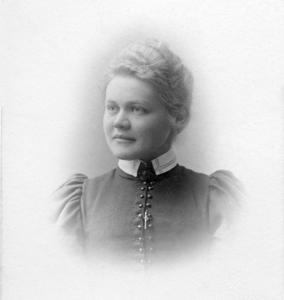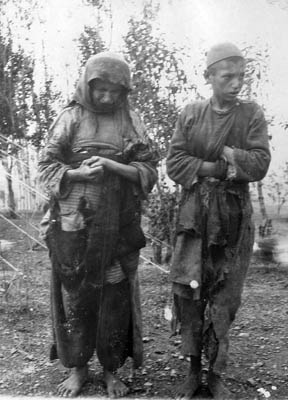Bodil Biørn
(1871-1960)

Bodil Biørn
In the latter stages of the 19th century, many European countries including various Scandinavian states went through a social and moral revolution where the awareness and protection of human rights took center stage. During this period of time, many human rights advocates emerged from the Scandinavian states of Sweden, Norway and Denmark. Moreover, learning about the fate of the Armenians in the Ottoman Empire and the horrible conditions imposed upon them, these human rights advocates took it upon themselves to visit East Anatolia and assist the tormented Armenians. One of these champions of humanitarianism is the Norwegian missionary Bodil Katharine Biørn.
Bodil Katharine Biørn was born on January 27th of 1871 in Kragerø, Norway. In 1905, the “Women Missionary Organization” sent Biørn to the Ottoman Empire as a missionary nurse. She was first based in the town of Mezereh in the Kharberd province and later in Mush. During her tenure in the Ottoman Empire, she cooperated with the German missionaries of Hülfsbund in an effort to help the widows and orphans. In 1915, she witnessed the Mush massacres, including the persecution and annihilation of the orphans in her custody and the murder of numerous Armenian priests, teachers and assistants. During the genocide, while many of her colleagues reverted to the role of bystander, Bodil Katharine Biørn became a witness and a messiah; saving the lives of hundreds of homeless Armenian women and children.
Furthermore, Bodil Biørn documented the events she witnessed through her testimonial diary and her photography. Her photographic album consists of various images of the genocide with descriptive comments on the back of each photo print.
Moreover, Biørn adopted a 2 years old Armenian orphan, who survived the genocide and in 1917, she took the boy named Rafael with her to Norway and baptized him as Nansen. Nansen (originally named Rafael) became her only son, as Biørn never got married in her life.
Going back to the Near East, Bodil took care of Armenian orphans in Syria, Lebanon and Constantinople. In 1922, while leaving her son behind at the Beirut French School, Bjorn moved to Soviet Armenia and founded an orphanage named “Lusaghbyur” in Alexandrapole. At the “Lusaghbyur” orphanage, she was known as “Mother Katharine” by the 33 orphans she took care of. Additionally, in 1924, the government of Soviet Armenia closed her small orphanage transferring the orphans to orphanages of Amercom, forcing Biørn to move to Syria and continue her noble work by aiding the Armenian refugees/survivors in Syria and Lebanon. Until 1935 Bodil Biørn worked with the Armenian refugees in Syria and Lebanon.
Last but not least, Bodil Biørn past away in 1960, leaving behind a legacy that will live forever.
. The footnotes of the photos were written by Bodil Biørn in verso of the photos.
. Selected photos are included in the online exhibition out of 300 archival photos made by Bodil Biørn .

Nurse Bodil Biørn on “Olaf”
Collection of Bodil Biørn

Bodil Biørn with her colleagues
Collection of Bodil Biørn

The Monastary St. Garabed (4th century, fully destroyed in 1915)
Collection of Bodil Biørn

The holy tomb of John Babtizers in St. Garabed (4th century, fully destroyed in 1915)
Collection of Bodil Biørn

National feast, dancers at St. Garabed (4-17th centuries, fully destroyed in 1915)
Collection of Bodil Biørn

Bodil Biorn’s fostered son Rupen, Mush
Collection of Bodil Biørn

A poor Armenian widow with her skinny little boy
Collection of Bodil Biørn

Chatschig from Siareb, a village near Mush, one of our boys. He was murdered in the massacres
Collection of Bodil Biørn

Euphrates near Deir-el-Zor, where so many of the deported were murdered. The river hides dark memories
Collection of Bodil Biørn

A poor Armenian vagrant family who received help
Collection of Bodil Biørn

Some of little Armenians girls with their dolls
Collection of Bodil Biorn

Ten children who had new clothes made for them for Christmas 1908 for money sent from a local group of WMW in Norway
Collection of Bodil Biørn

Widow Ankin Aslanjan
Collection of Bodil Biørn

Armenian woman Arek Manukyan with her children, Mush 1916
Collection of Bodil Biørn
Norwegian State archive

Widow Gulo Bedrossian
Collection of Bodil Biørn

Widow Jeghsa Jeghiasarian
Collection of Bodil Biørn

Widow Jeghse Muradian
Collection of Bodil Biørn

Widow Jevnige Harutunian
Collection of Bodil Biørn

Widow Mawie Bedrossian
Collection of Bodil Biørn

Widow Rejas Harutyunyan with her children, Mush 1916
Collection of Bodil Biørn
Norwegian State archive

Widow Salwi Bedrossian
Collection of Bodil Biørn

Widow Wartuhi Bedrossian
Collection of Bodil Biørn

Widow Vartuhi Bedrosyan with her children, Mush 1916
Collection of Bodil Biørn
Norwegian State archive

Widow Zirpuhi Maderossian
Collection of Bodil Biørn

Widow Findik Arakeljan
Collection of Bodil Biørn
Norwegian State archive

Widow Guta Thorosian
Collection of Bodil Biørn
Norwegian State archive

Widow Margarite Hatschigian
Collection of Bodil Biørn
Norwegian State archive

Widow Sanam Krikorian
Collection of Bodil Biørn

Widow Shushan Sarkissian
Collection of Bodil Biørn

Part of the large refugee camp in Aleppo, where about 12 000 people were living
Collection of Bodil Biørn

Four generations in an Armenian refugee home in Beirut
Collection of Bodil Biørn

“One of the classes in the day-school in Mush with their teacher Margarid… The teacher Margarid Nalbanchian and most of the 120 children of the day-school were murdered in 1915”. The quoted text was written by Bodil Biørn in verso of the photo.
They all were murdered in 1915
Collection of Bodil Biørn

Armenian leader Papasian looking at the human remains of the terrible massacres at Der-el-Zor in 1915-1916. Other bones have been washed away by the Euphrates
Collection of Bodil Biørn
Photo sources: Norwegian State archive
© Armenian Genocide Museum-Institute
© Collection of Bodil Biørn
© Norwegian State archive





